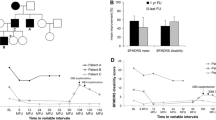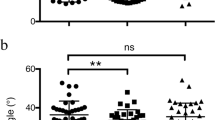Abstract
Camptocormia, characterised by a forward flexion of the thoracolumbar spine may occur in various movement disorders, mainly in Parkinson’s disease or in primary dystonia. In severe cases, patients with camptocormia are unable to walk. While treatment options are limited, deep brain stimulation (DBS) with bilateral stimulation of the subthalamic nucleus or globus pallidus internus (GPi) has been proposed as a therapeutic option in refractory cases of Parkinson’s disease. Here we present two patients with severe camptocormia as an isolated form of dystonia and as part of generalised dystonia, respectively, which were both treated with bilateral stimulation of the GPi. Symptoms of dystonia were assessed using the Burke–Fahn–Marsden dystonia rating scale (BFM) before and during deep brain stimulation. In both patients there was a significant functional improvement following long-term bilateral GPi stimulation and both patients gained ability to walk. In the first patient with an isolated dystonic camptocormia the BFM motor subscore for the truncal flexion improved by 75 %. The total BFM motor score in the second patient with a camptocormia in generalised dystonia improved by 45 %, while the BFM score for truncal flexion improved by 87 %. In both patients the effect of the bilateral GPi stimulation on camptocormia was substantial, independent of generalisation of dystonia. Therefore, GPi DBS is a possible treatment option for this rare disease.


Similar content being viewed by others
References
Azher SN, Jankovic J (2005) Camptocormia: pathogenesis, classification, and response to therapy. Neurology 65(3):355–359. doi:10.1212/01.wnl.0000171857.09079.9f
Serratrice G (2007) Clinical semiology of neuromuscular diseases. Bent spine myopathy or syndrome. Acta myol: myopathies and cardiomyopathies: Official Journal of the Mediterranean Society of Myology/edited by the Gaetano Conte Academy for the study of striated muscle diseases 26(1):1–4
Skidmore F, Anderson K, Fram D, Weiner W (2007) Psychogenic camptocormia. Mov Disord: Off J Mov Disord Soc 22(13):1974–1975. doi:10.1002/mds.21708
Reichel G, Kirchhofer U, Stenner A (2001) Camptocormia–segmental dystonia. Proposal of a new definition for an old disease. Der Nervenarzt 72(4):281–285
Bloch F, Houeto JL, Tezenas du Montcel S, Bonneville F, Etchepare F, Welter ML, Rivaud-Pechoux S, Hahn-Barma V, Maisonobe T, Behar C, Lazennec JY, Kurys E, Arnulf I, Bonnet AM, Agid Y (2006) Parkinson’s disease with camptocormia. J Neurol Neurosurg Psychiatry 77(11):1223–1228. doi:10.1136/jnnp.2006.087908
Peek AC, Quinn N, Casey AT, Etherington G (2009) Thoracolumbar spinal fixation for camptocormia in Parkinson’s disease. J Neurol Neurosurg Psychiatry 80(11):1275–1278. doi:10.1136/jnnp.2008.152736
Deuschl G, Schade-Brittinger C, Krack P, Volkmann J, Schafer H, Botzel K, Daniels C, Deutschlander A, Dillmann U, Eisner W, Gruber D, Hamel W, Herzog J, Hilker R, Klebe S, Kloss M, Koy J, Krause M, Kupsch A, Lorenz D, Lorenzl S, Mehdorn HM, Moringlane JR, Oertel W, Pinsker MO, Reichmann H, Reuss A, Schneider GH, Schnitzler A, Steude U, Sturm V, Timmermann L, Tronnier V, Trottenberg T, Wojtecki L, Wolf E, Poewe W, Voges J (2006) A randomized trial of deep-brain stimulation for Parkinson’s disease. N Engl J Med 355(9):896–908. doi:10.1056/NEJMoa060281
Follett KA, Weaver FM, Stern M, Hur K, Harris CL, Luo P, Marks WJ Jr, Rothlind J, Sagher O, Moy C, Pahwa R, Burchiel K, Hogarth P, Lai EC, Duda JE, Holloway K, Samii A, Horn S, Bronstein JM, Stoner G, Starr PA, Simpson R, Baltuch G, De Salles A, Huang GD, Reda DJ (2010) Pallidal versus subthalamic deep-brain stimulation for Parkinson’s disease. N Engl J Med 362(22):2077–2091. doi:10.1056/NEJMoa0907083
Hellmann MA, Djaldetti R, Israel Z, Melamed E (2006) Effect of deep brain subthalamic stimulation on camptocormia and postural abnormalities in idiopathic Parkinson’s disease. Mov Disord: Off J Mov Disord Soc 21(11):2008–2010. doi:10.1002/mds.21090
Yamada K, Goto S, Matsuzaki K, Tamura T, Murase N, Shimazu H, Nagahiro S, Kuratsu J, Kaji R (2006) Alleviation of camptocormia by bilateral subthalamic nucleus stimulation in a patient with Parkinson’s disease. Parkinsonism Relat Disord 12(6):372–375. doi:10.1016/j.parkreldis.2006.02.003
Sako W, Nishio M, Maruo T, Shimazu H, Matsuzaki K, Tamura T, Mure H, Ushio Y, Nagahiro S, Kaji R, Goto S (2009) Subthalamic nucleus deep brain stimulation for camptocormia associated with Parkinson’s disease. Mov Disord:Off J Mov Disord Soc 24(7):1076–1079. doi:10.1002/mds.22529
Kupsch A, Benecke R, Muller J, Trottenberg T, Schneider GH, Poewe W, Eisner W, Wolters A, Muller JU, Deuschl G, Pinsker MO, Skogseid IM, Roeste GK, Vollmer-Haase J, Brentrup A, Krause M, Tronnier V, Schnitzler A, Voges J, Nikkhah G, Vesper J, Naumann M, Volkmann J (2006) Pallidal deep-brain stimulation in primary generalized or segmental dystonia. N Engl J Med 355(19):1978–1990. doi:10.1056/NEJMoa063618
Micheli F, Cersosimo MG, Piedimonte F (2005) Camptocormia in a patient with Parkinson disease: beneficial effects of pallidal deep brain stimulation. Case report. J Neurosurg 103(6):1081–1083. doi:10.3171/jns.2005.103.6.1081
Nandi D, Parkin S, Scott R, Winter JL, Joint C, Gregory R, Stein J, Aziz TZ (2002) Camptocormia treated with bilateral pallidal stimulation. J Neurosurg 97(2):461–466. doi:10.3171/jns.2002.97.2.0461
Capelle HH, Schrader C, Blahak C, Fogel W, Kinfe TM, Baezner H, Krauss JK (2011) Deep brain stimulation for camptocormia in dystonia and Parkinson’s disease. J Neurol 258(1):96–103. doi:10.1007/s00415-010-5695-0
Comella CL, Leurgans S, Wuu J, Stebbins GT, Chmura T (2003) Rating scales for dystonia: a multicenter assessment. Mov Disord:Off J Mov Disord Soc 18(3):303–312. doi:10.1002/mds.10377
Fukaya C, Otaka T, Obuchi T, Kano T, Nagaoka T, Kobayashi K, Oshima H, Yamamoto T, Katayama Y (2006) Pallidal high-frequency deep brain stimulation for camptocormia: an experience of three cases. Acta Neurochirurgica Suppl 99:25–28
Lozano AM, Hutchison WD (2002) Microelectrode recordings in the pallidum. Mov Disord:Off J Mov Disord Soc 17(Suppl 3):S150–S154
Tisch S, Zrinzo L, Limousin P, Bhatia KP, Quinn N, Ashkan K, Hariz M (2007) Effect of electrode contact location on clinical efficacy of pallidal deep brain stimulation in primary generalised dystonia. J Neurol Neurosurg Psychiatry 78(12):1314–1319. doi:10.1136/jnnp.2006.109694
Vayssiere N, van der Gaag N, Cif L, Hemm S, Verdier R, Frerebeau P, Coubes P (2004) Deep brain stimulation for dystonia confirming a somatotopic organization in the globus pallidus internus. J Neurosurg 101(2):181–188. doi:10.3171/jns.2004.101.2.0181
Conflicts of interest
T. Hagenacker, M. Gerwig, D. Miller, O. Kastrup, D. Jokisch, U. Sure and M. Frings have no actual or potential financial and other conflict of interest related to the submitted manuscript. T. Gasser received honoraria from Medtronic Navigation Systems and is member of the technical advisory board.
Author information
Authors and Affiliations
Corresponding author
Electronic supplementary material
Below is the link to the electronic supplementary material.
Patient #1, preoperative: Even with a walking frame, walking is possible only over a short distance. Postoperative: For walking upright, the use of a walking frame is no longer necessary (MPG 4050 kb)
Patient #2, preoparative: Walking upright is not possible. Postoperative: The patient is able to walk without truncal flexion. Generalised signs of dystonia persist (MPG 4936 kb)
Rights and permissions
About this article
Cite this article
Hagenacker, T., Gerwig, M., Gasser, T. et al. Pallidal deep brain stimulation relieves camptocormia in primary dystonia. J Neurol 260, 1833–1837 (2013). https://doi.org/10.1007/s00415-013-6885-3
Received:
Revised:
Accepted:
Published:
Issue Date:
DOI: https://doi.org/10.1007/s00415-013-6885-3




